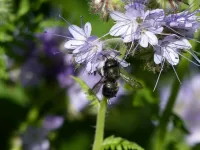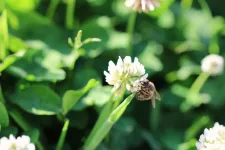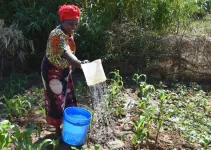(Press-News.org) URBANA, Ill. ¬- Illinois residents value efforts to reduce watershed pollution, and they are willing to pay for environmental improvements, according to a new study from agricultural economists at the University of Illinois.
Nutrient runoff from agricultural production is a major cause of pollution in the Mississippi River Basin and contributes to hypoxia - limited oxygen to support sea life in the Gulf of Mexico. The U.S. Environmental Protection Agency (EPA) set up action plans to reduce pollution in 12 midwestern states and reduce transmissions of nitrate-nitrogen and phosphorus by 45% in 2040.
Illinois agencies have established the Illinois Nutrient Loss Reduction Strategy (INLRS) to address those issues, relying on voluntary efforts as well as policy measures such as state subsidies. Understanding the level of support from local residents can help inform nutrient reduction initiatives.
"We know water quality is important and water pollution has costs in terms of both health and economic damages," says Bryan Parthum, lead author on the paper. Parthum was a graduate student in the Department of Agricultural and Consumer Economics at U of I when the study was conducted; he now works as an economist in the EPA Office of Policy.
"We wanted to find out how much people care about local water quality, fish populations, and algal blooms, and how much they care about meeting EPA targets which benefit the Gulf of Mexico," Parthum explains.
The researchers surveyed respondents in the Upper Sangamon River Watershed in Central Illinois, an INLRS priority watershed due to high levels of nitrate and phosphorus transmission.
Respondents completed a choice experiment survey containing different scenarios that described water quality improvements such as reducing algal bloom, increasing the overall fish population and number of fish species, and meeting EPA targets for reducing nutrient pollution.
The scenarios also included information about proximity to the respondent, and a range of potential costs associated with those measures.
The researchers could then estimate how much people were willing to pay for the various improvements. For example, a 50% reduction of algal blooms in the watershed would, on average, be worth $32 annually per household.
"And if you combine reduced algal blooms, improved fish population and diversity, and meeting the nutrient targets, that whole bundle is worth $85 per household," Parthum says.
Amy Ando, professor of agricultural and consumer economics at U of I and co-author of the paper, notes the Sangamon River isn't known as a tourist destination, yet still holds value for recreational purposes. Close to 50% of respondents indicated using the river for fishing, boating, or hiking at least once a year.
"The actions taken by the INLRS, if successful, will reduce hypoxia in the Gulf of Mexico, and people in Illinois care about doing that. But the strategies also have value for improvements in fish populations and reductions in algal blooms right here at home, so people get some local benefits as well," Ando notes.
The survey included 373 respondents, about evenly divided between urban and rural residents. The researchers observed no difference in attitudes towards water policy measures among the two groups.
"There may be a perception that urban residents care more about environmental improvements. But we found both urban and rural groups expressed value for improved fish populations and water quality in the rivers that run through where they live," Ando says.
INFORMATION:
The paper, "Overlooked benefits of nutrient reductions in the Mississippi River Basin," is published in Land Economics. Partial funding provided by USDA-NIFA Grant #1008843.
The Department of Agricultural and Consumer Economics is in the College of Agricultural, Consumer and Environmental Sciences (ACES) at the University of Illinois.
Recently there has been a reemergence of interest in optical computing platforms for artificial intelligence-related applications. Optics/photonics is ideally suited for realizing neural network models because of the high speed, large bandwidth and high interconnectivity of optical information processing. Introduced by UCLA researchers, Diffractive Deep Neural Networks (D2NNs) constitute such an optical computing framework, comprising successive transmissive and/or reflective diffractive surfaces that can process input information through light-matter interaction. These surfaces are designed using standard deep learning techniques ...
CORVALLIS, Ore. - Researchers at Oregon State University have found that the blue orchard bee, an important native pollinator, produces female offspring at higher rates in the aftermath of wildfire in forests.
The more severe the fire had been, the greater percentage of females - more than 10% greater in the most badly burned areas relative to areas that burned the least severely.
"This is one of the first studies that has looked at how forest fire severity influences bee demography," said Jim Rivers, an animal ecologist with the OSU College of Forestry. "Sex ratio varied under different fire conditions but the number of young produced did not, which indicates bees ...
A first-of-its-kind, international study of 107,000 children finds that higher temperatures are an equal or even greater contributor to child malnutrition and low quality diets than the traditional culprits of poverty, inadequate sanitation, and poor education.
The 19-nation study is the largest investigation of the relationship between our changing climate and children's diet diversity to date. It is believed to be the first study across multiple nations and continents of how both higher temperatures and rainfall--two key results of climate change--have impacted children's diet diversity.
"Certainly, future climate changes have been predicted to affect malnutrition, but it surprised ...
DALLAS, Jan. 14, 2021 -- The longer the time between when heart attack symptoms start and a patient has an artery-clearing percutaneous coronary intervention (PCI), the more damage to the heart muscle, according to new research published today in Circulation: Cardiovascular Interventions, an American Heart Association journal.
A heart attack happens about every 40 seconds in the U.S., and the most common heart attack is caused by a complete blockage in a coronary artery, called ST-elevation myocardial infarction (STEMI). STEMI patients are most often treated with PCI, also known as angioplasty with stent, in which a catheter with a deflated balloon is inserted into the narrowed heart artery. Subsequently, the balloon is inflated, which clears the obstruction and restores ...
DALLAS, Jan. 14, 2021 -- Adults who smoke or who are genetically predisposed to smoking behaviors are more likely to experience a serious type of stroke called subarachnoid hemorrhage (SAH), according to new research published today in Stroke, a journal of the American Stroke Association, a division of the American Heart Association. The results of this study provide important evidence that there is a causal link between smoking and the risk of SAH.
SAH is a type of stroke that occurs when a blood vessel on the surface of the brain ruptures and bleeds into the space between the brain and the skull. It mainly affects middle-aged adults and has high rates of complications ...
MEDFORD/SOMERVILLE (January 14, 2021) - A team of researchers led by engineers at Tufts University's School of Engineering and Stanford University's Program on Water, Health and Development have developed a novel and inexpensive chlorine dispensing device that can improve the safety of drinking water in regions of the world that lack financial resources and adequate infrastructure. With no moving parts, no need for electricity, and little need for maintenance, the device releases measured quantities of chlorine into the water just before it exits the tap. It provides a quick and ...
There is a growing consensus among scientists as well as national and local governments representing hundreds of millions of people, that humanity faces a climate crisis that demands a crisis response. New research from the University of California San Diego explores one possible mode of response: a massively funded program to deploy direct air capture (DAC) systems that remove CO2 directly from the ambient air and sequester it safely underground.
The findings reveal such a program could reverse the rise in global temperature well before 2100, but only with immediate and sustained investments from governments and firms to scale up the new technology.
Despite the enormous undertaking explored in the study, the research ...
Honeybee historians might seem like a flight of fancy but these tiny pollinators have been helping researchers from the National Botanic Garden of Wales track how the UK's fields, hedgerows, wild spaces and gardens have changed since the 1950s.Using cutting-edge DNA barcoding techniques, scientists at the Botanic Garden identified which plants modern-day honeybees visited most often by looking at the pollen grains trapped within honey.
They compared this to a 1952 survey of honey plants where a microscope had been used to painstakingly identify pollen grains in honey sent from hives across the country. The differences were clear. White clover had been the most important plant for honeybees but, with fewer pastures today and increased use of herbicides and inorganic ...
New research has unlocked the mystery of how the Galápagos Islands, a rocky, volcanic outcrop, with only modest rainfall and vegetation, is able to sustain its unique wildlife habitats.
The Galápagos archipelago, rising from the eastern equatorial Pacific Ocean some 900 kilometres off the South American mainland, is an iconic and globally significant biological hotspot. The islands are renowned for their unique wealth of endemic species, which inspired Charles Darwin's theory of evolution and today underpins one of the largest UNESCO World Heritage Sites and Marine Reserves on Earth.
Scientists have known ...
Water isn't just crucial for life, it's fundamental to increasing opportunities for women and girls in rural areas across the globe. A new Stanford study reveals how bringing piped water closer to remote households in Zambia dramatically improves the lives of women and girls, while also improving economic opportunities, food security and well-being for entire households. The research, recently published in Social Science & Medicine, could spur governments and NGOs to more carefully evaluate the costs and benefits of piped water as an alternative to less accessible communal water sources.
"Switching from the village borehole to piped supply saved almost 200 hours of fetching time per year for a typical household," said study senior ...








